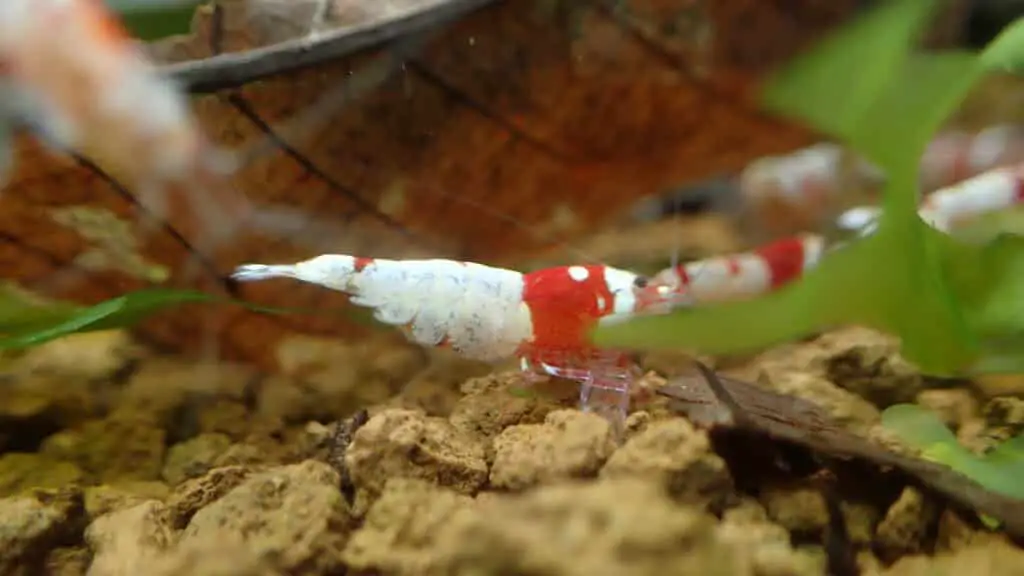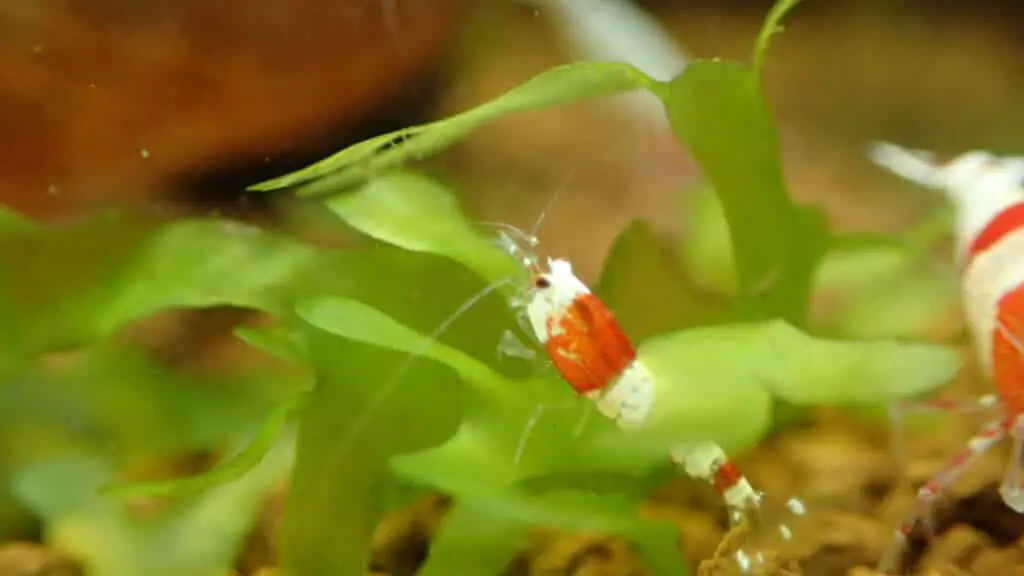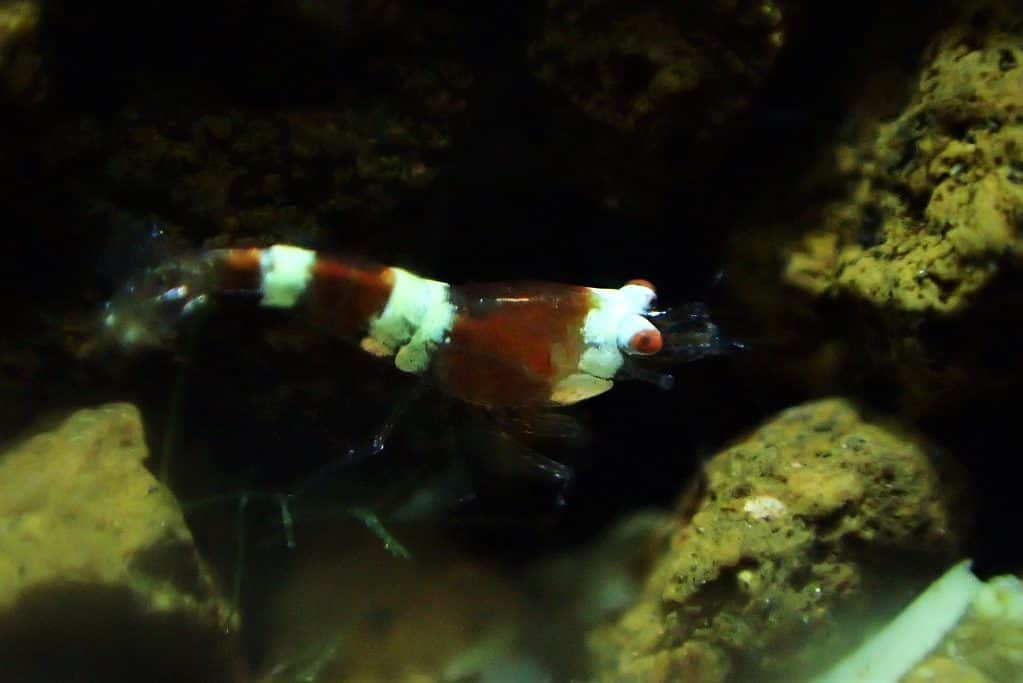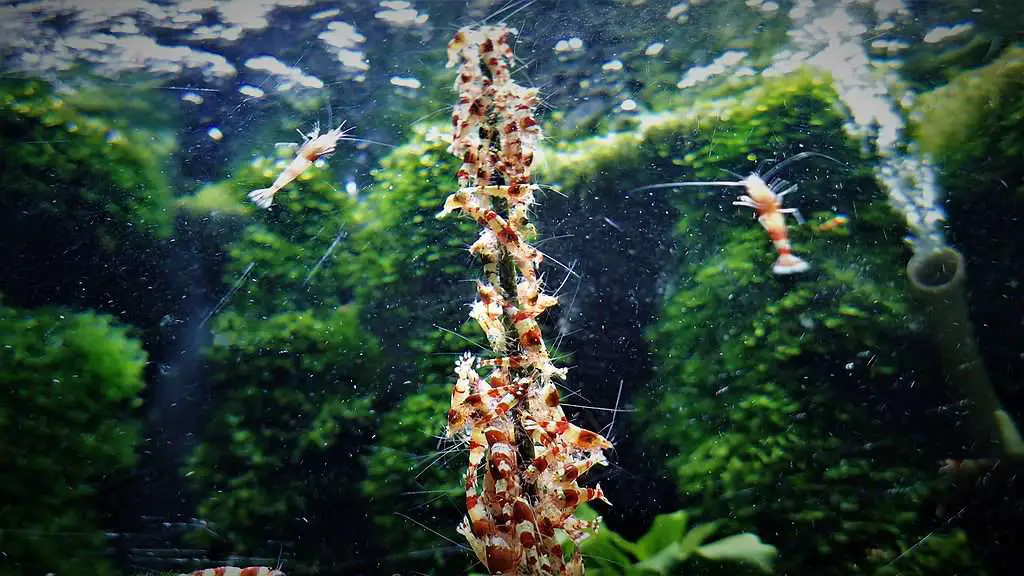Crystal Red Shrimp thrive best in water temperatures in the low 70s Fahrenheit (around 22-24 degrees Celsius). They can tolerate temperatures up to 76-78 degrees Fahrenheit, but higher temperatures are not optimal and can affect their health and coloration.
Hello shrimpfam, as a seasoned shrimp keeper, I’ve spent countless hours observing and caring for these fascinating creatures. One species that has always intrigued me is the Crystal Red Shrimp (CRS). These little guys are visually stunning and have specific needs that differ from other shrimp species. Over the years, I’ve found that maintaining the correct water temperature is one of the most critical factors in their care.
I remember when I first started keeping CRS, I was a bit perplexed about the right temperature for their tank. I had read that they preferred cooler temperatures, but my tank seemed to hover around the 76-78 degrees mark. I was worried. Would this higher temperature affect my shrimp?
After much research and personal experience, I found that while CRS can survive in these higher temperatures, it’s not the most optimal environment for them. The ideal temperature for these shrimp is in the low 70s. This discovery led me to make some changes in my shrimp-keeping routine, and I’ve seen a noticeable improvement in the health and vitality of my CRS since then.
me to make some changes in my shrimp-keeping routine, and I’ve seen a noticeable improvement in the health and vitality of my CRS since then.
In this blog post, I’ll share my insights and experiences on this topic, hoping to help other shrimp enthusiasts create the best environment for their CRS. Remember, the key to successful shrimp keeping is understanding and meeting their specific needs.

The Importance of Correct Water Temperature for Crystal Red Shrimp
When it comes to keeping Crystal Red Shrimp (CRS), one of the most crucial factors to consider is the water temperature. These delicate creatures are sensitive to their environment, and the temperature of their habitat plays a significant role in their overall health and well-being.
The ideal temperature for CRS is in the low 70s (Fahrenheit). This range closely mimics the natural environment of these shrimp, providing them with conditions that are conducive to their survival and growth. When the water temperature is within this range, CRS can thrive, displaying vibrant colors and engaging in normal behaviors such as foraging, molting, and breeding.
Maintaining the correct water temperature is not just about ensuring the comfort of your shrimp. It’s also about promoting their longevity and reducing the risk of stress-related issues. When the water temperature is too high or fluctuates frequently, it can cause stress to the shrimp, potentially leading to health problems and even premature death.
High temperatures can speed up the metabolism of the shrimp, causing them to eat more and grow faster. While this might seem like a good thing, it can actually lead to a shorter lifespan for the shrimp. On the other hand, temperatures that are too low can slow down their metabolism, leading to less activity and slower growth.
Moreover, temperature plays a role in the oxygen levels in the water. Warmer water holds less oxygen than cooler water, which can lead to oxygen deprivation for the shrimp. This can be particularly problematic in a densely populated tank.

How Temperature Affects the Health and Behavior of Crystal Red Shrimp
Temperature plays a pivotal role in the health and behavior of Crystal Red Shrimp (CRS). It influences their metabolic rate, breeding habits, molting cycle, and overall activity levels. Let’s dive deeper into how these aspects are affected by temperature.
- Metabolic Rate: The metabolic rate of CRS is directly influenced by the temperature of their environment. In warmer temperatures, their metabolism speeds up. This means they eat more, grow faster, and produce waste more frequently. While this might seem beneficial, it can actually lead to a shorter lifespan as the shrimp essentially ‘burn out’ faster. Conversely, in cooler temperatures, their metabolism slows down. They eat less, grow slower, and produce less waste, which can lead to a longer lifespan but slower growth rate.
- Breeding Habits: Temperature also affects the breeding habits of CRS. They tend to breed more successfully in temperatures within their preferred range (low 70s Fahrenheit). Higher temperatures can lead to increased breeding activity, but it can also result in higher mortality rates among the offspring. Lower temperatures, on the other hand, can slow down or even halt breeding activity.
- Molting Cycle: Molting is a crucial process for CRS, allowing them to grow and replace damaged or lost limbs. The frequency of molting is influenced by the water temperature. In warmer water, CRS molt more frequently due to their increased metabolic rate. However, frequent molting can be stressful for the shrimp and can lead to molting issues if the water quality is not optimal. In cooler water, the molting process slows down, aligning with their slower growth rate.
- Activity Levels: Lastly, the overall activity level of CRS is affected by temperature. They are generally more active in their preferred temperature range. In warmer water, they may become overly active, which can lead to stress. In contrast, in cooler water, their activity levels may decrease, and they may become less responsive.

Signs Your Crystal Red Shrimp May Be Uncomfortable with the Water Temperature
Crystal Red Shrimp (CRS) are delicate creatures, and their comfort and well-being are directly tied to the conditions of their environment. One of the most influential factors is the temperature of the water in their tank. If the temperature is not within their preferred range, they may exhibit signs of discomfort or stress. Here are some signs that your CRS may be uncomfortable with the water temperature:
- Decreased Activity: If your CRS are less active than usual, it could be a sign that the water temperature is not optimal. Shrimp that are too cold may become lethargic and spend more time hiding rather than foraging or exploring. On the other hand, shrimp in overly warm water may appear overly active or agitated.
- Changes in Eating Habits: Changes in your shrimp’s eating habits can also indicate discomfort with the water temperature. In warmer temperatures, their metabolism speeds up, and they may eat more than usual. Conversely, in cooler temperatures, their metabolism slows down, and they may eat less.
- Difficulty Molting: Molting is a natural process for shrimp, allowing them to grow and replace damaged or lost limbs. However, if the water temperature is too high or too low, it can disrupt this process, leading to molting issues. If you notice incomplete molts or shrimp struggling to shed their old exoskeleton, it could be a sign that the water temperature is not optimal.
- Decreased Breeding: If you notice a decrease in breeding activity or a high mortality rate among offspring, it could be a sign that the water temperature is too high or too low. CRS tend to breed more successfully in temperatures within their preferred range (low 70s Fahrenheit).
- Color Loss: CRS are known for their vibrant red and white coloration. However, stress from unsuitable water temperatures can lead to a loss of color. If your shrimp are looking less colorful than usual, it might be time to check the water temperature.
- Increased Mortality: If you’re experiencing a higher than normal mortality rate among your CRS, it could be a sign that the water temperature is not suitable. Sudden or drastic changes in temperature can be particularly harmful and can lead to shock and death.
These signs can also be indicative of other issues, such as poor water quality or disease, so it’s essential to consider all possible factors when assessing the health and comfort of your shrimp. Regular monitoring and adjustment of water temperature can help ensure a comfortable and healthy environment for your Crystal Red Shrimp.

Adjusting and Maintaining the Right Water Temperature for Crystal Red Shrimp: The Role of Equipment
Maintaining the right water temperature for Crystal Red Shrimp (CRS) is crucial for their health and well-being. The right equipment can make all the difference in achieving this. Here’s a look at some of the key pieces of equipment and strategies that can help regulate water temperature:
- Aquarium Heater and Thermometer
 : A reliable aquarium heater and thermometer are essential tools. The heater allows you to adjust the temperature as needed, while the thermometer helps you monitor the current temperature. Choose a heater with a thermostat for automatic temperature control.
: A reliable aquarium heater and thermometer are essential tools. The heater allows you to adjust the temperature as needed, while the thermometer helps you monitor the current temperature. Choose a heater with a thermostat for automatic temperature control. - Gradual Changes: Any changes to the water temperature should be made gradually. Sudden changes can cause stress and shock to the shrimp, which can be harmful or even fatal. Aim for no more than a 2-degree change per day.
- Location Considerations: Place your shrimp tank in a location that avoids direct sunlight and is away from heat sources like radiators or vents. These can cause the water temperature to rise rapidly.
- Fans or Chillers: If the water temperature gets too high, especially in the summer months, you can use fans or aquarium chillers to cool it down. Fans increase evaporation, which cools the water, while chillers actively cool the water.
- Regular Monitoring: Regularly monitor the water temperature using your thermometer. Check it at different times of the day, as the temperature can fluctuate between day and night.
- Water Changes: When performing water changes, make sure the new water is the same temperature as the tank water. This helps avoid sudden temperature changes that can stress the shrimp.
- Insulation: In colder months, you can use insulation around the tank to help maintain a steady temperature. This can be particularly useful if your tank is in a location that gets cold, like a basement.
- Automatic Temperature Controller: For advanced hobbyists, an automatic temperature controller can be used. These devices connect to your heater and/or chiller and automatically adjust their operation to maintain a set temperature.
Remember, the ideal temperature for CRS is in the low 70s (Fahrenheit). Maintaining this temperature range will help ensure your shrimp are comfortable, healthy, and active. Regular monitoring and adjustments as needed are key to successful temperature management in your shrimp tank.

Common Mistakes in Managing Water Temperature for Crystal Red Shrimp
Managing the water temperature for Crystal Red Shrimp (CRS) is a delicate task, and it’s easy to make mistakes, especially if you’re new to shrimp keeping. Here are some common mistakes to avoid:
- Ignoring Temperature Fluctuations: One of the most common mistakes is ignoring temperature fluctuations. Even small changes in temperature can stress your shrimp, so it’s essential to monitor the temperature regularly and take steps to maintain stability.
- Making Rapid Changes: Another common mistake is making rapid changes to the water temperature. Whether you’re trying to raise or lower the temperature, it’s important to do so gradually. Sudden changes can shock your shrimp and lead to health problems or even death.
- Overheating the Tank: Overheating the tank is a common issue, especially in warmer climates or during the summer months. Remember, CRS prefer cooler temperatures in the low 70s (Fahrenheit). If the temperature gets too high, it can stress your shrimp and lead to health issues.
- Assuming Room Temperature Is Enough: While room temperature can influence the water temperature, it’s not always enough on its own. The water temperature can be affected by various factors, including sunlight, proximity to heat sources, and the use of lighting or other equipment. If your room temperature consistently drops below 20 degrees Celsius, consider using a heater.
- Not Preparing for Power Outages: Power outages can cause the water temperature to drop rapidly, especially in colder climates or during winter months. It’s important to have a plan in place for maintaining the water temperature during a power outage, such as using battery-operated heaters or insulating the tank.
- Using the Wrong Equipment: Using the wrong equipment, or using it incorrectly, can lead to temperature issues. For example, a heater that’s too powerful for your tank size can cause overheating, while a heater that’s too weak may not be able to maintain the desired temperature. Always choose equipment that’s appropriate for your tank size and the needs of your shrimp.
By avoiding these common mistakes, you can maintain a stable, comfortable environment for your Crystal Red Shrimp. Remember, maintaining the right water temperature is crucial for the health and well-being of your shrimp, so it’s worth taking the time to get it right.

Conclusion
In the world of shrimp keeping, maintaining the right water temperature is not just a recommendation, but a necessity. Crystal Red Shrimp, with their specific needs, rely on us to provide an environment that closely mimics their natural habitat. This includes a water temperature in the low 70s (Fahrenheit), a range in which they can truly thrive.
From understanding the importance of correct water temperature, recognizing signs of discomfort in your shrimp, to adjusting and maintaining the right temperature, each step plays a crucial role in the well-being of your shrimp. Equipping yourself with the right tools and knowledge can make a significant difference in your shrimp keeping journey.
Remember, mistakes can happen, especially when you’re new to this hobby. But don’t let this discourage you. Every mistake is an opportunity to learn and grow as a shrimp keeper.
If you need any help or have any questions, please don’t hesitate to reach out. I’m here to assist you in creating the best environment for your Crystal Red Shrimp.
Happy Shrimp Keeping!

FAQ: All About Crystal Red Shrimp Care
Q. What temperature do Crystal Red shrimp like in Celsius?
A. Crystal Red Shrimp prefer a temperature range of about 22-24 degrees Celsius. This range provides a comfortable environment that closely mimics their natural habitat.
Q. Do Crystal Red shrimp need a heater?
A. Yes, a heater is recommended for Crystal Red Shrimp. It helps maintain a stable temperature in the tank, which is crucial for their health and well-being.
Q. Are Crystal Red shrimp hardy?
A. Crystal Red Shrimp are not considered as hardy as some other shrimp species. They have specific care requirements, including a need for stable, cooler water temperatures.
Q. How fast do Crystal Red shrimp grow?
A. The growth rate of Crystal Red Shrimp can vary, but generally, they reach maturity in about 4-6 months. The rate can be influenced by factors like diet and water temperature.
Q. Are Crystal Red shrimp sensitive?
A. Yes, Crystal Red Shrimp are sensitive to changes in their environment, particularly water temperature and quality. They require stable conditions to thrive.
Q. Can I use tap water for Crystal Red shrimp?
for Crystal Red shrimp?
A. Tap water can be used for Crystal Red Shrimp, but it must be treated to remove chlorine and other harmful chemicals. It’s also important to match the water parameters to their needs.
